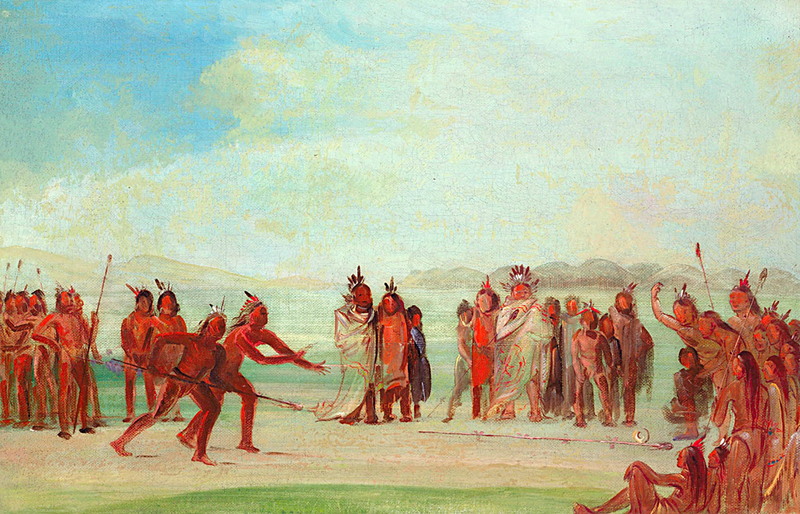
Chunkey (pronounced “tchung-kee”) was a sport played by Native Americans across much of North America, especially in the southeastern region. The game involved rolling a small circular stone and trying to land a long pole near its final resting place. Different tribes had different ways to play, but there were many commonalities among all the variants. It was a wildly popular spectator sport that brought together entire tribes and even Europeans visitors after colonization.
Chunkey carried heavy cultural significance among Native American tribes. Players sometimes wore ritualistic clothes, accessories, and face paint for more important games. Symbols on chunkey-related artifacts seem to indicate that losing was associated with death. In fact, some players were known to commit suicide after losing a game on which they had wagered much of their possessions.
Origins and History
Chunkey is thought to originate with the people of the Cahokia region (near the Mississippi River) as early as the 7th century AD. From that period, it spread to other tribes including the Cherokees, Chickasaws, Choctaws, Mandans, and others. Its history isn’t well-recorded before European contact, so most of what we know of the sport is only a snapshot of that period. The game fell out of popularity sometime after the 19th century.
How to Play
Chunkey was typically played by two opposing teams. One player from each team would be selected; one to roll the stone wheel or ring and the other to toss the stick (also called the chunkey). Both of them would run or sprint for a short distance, one would roll the stone, and the other would throw the stick immediately afterward. The chunkey would be thrown underhand, as the goal was for it slide along the ground and stop as close to the stone’s final resting position as possible. It was not thrown overhand to stick in the ground like a spear.
Scoring systems varied among tribes. The Mandans tied leather strips to the stick that would jut outward an inch or two, and to goal was for one of these strips to stick through the ring as it fell. The Chickasaws had multiple people throw chunkeys, and whoever ended up closest to the resting stone scored a point (two if it was touching). The Cherokees and Choctaws marked their sticks and awarded points based on which marks the ring was closest to.
Equipment
The ring used for chunkey was a small piece of carved stone ranging from 2 to 8 inches in diameter, sometimes with a hole in the center (as in the case of the Mandans). These stones could be left plain or decorated with basic carvings. Their faces were often carved out concavely, making them narrower in the center.
The chunkey was a long pole, typically around 6 feet, made of various types of wood. Depending on the tribe, the stick featured different decorations and markings, such as leather straps and notches, as detailed above.
[raw_html_snippet id=”bib”]
King, C. R. (2004). Native Americans in sports. Armonk, NY: Sharpe Reference.
Reilly, F. K., & Garber, J. (2009). Ancient objects and sacred realms: Interpretations of Mississippian iconography. Austin: University of Texas Press.
Bowne, E. E. (2013). Mound Sites of the Ancient South: A Guide to the Mississippian Chiefdoms. University of Georgia.
Pauketat, T. R. (2004). Ancient Cahokia and the Mississippians. Cambridge, U.K.: Cambridge University Press.
Hudson, C. M. (1978). The Southeastern Indians. University of Tennessee Press.
[raw_html_snippet id=”endbib”]